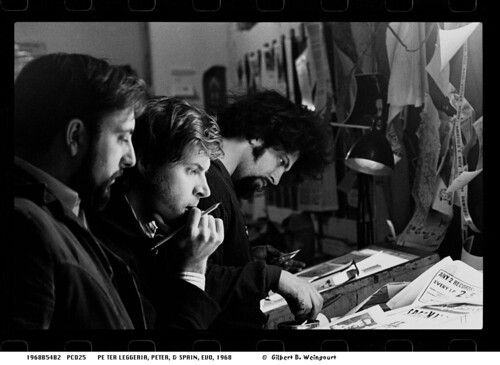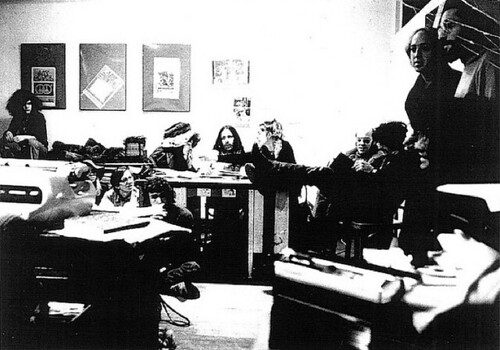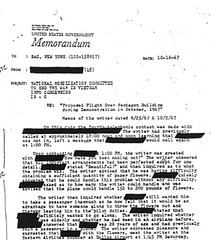Earlier this week, the Arthur L. Carter Journalism Institute launched “Blowing Minds: The East Village Other, the Rise of Underground Comix and the Alternative Press, 1965-72,” with a rousing discussion that’s now archived on the exhibit’s Website, along with new audio interviews with veterans of the Other. Over the course of seven weekend editions of The Local, we’ve heard from all but one of the EVO alumni who spoke on Tuesday’s panel. Here now, to cap off our special series, is the story of Peter Leggieri.
 Gil Weingourt Left to right: Peter Leggieri, Peter Mikalajunas, and Spain Rodriguez.
Gil Weingourt Left to right: Peter Leggieri, Peter Mikalajunas, and Spain Rodriguez.From the first day that I began working at The East Village Other, I was overcome by the sense that it was not only a newspaper but a strange and magical ship on a voyage with destiny. It seemed as though each issue printed was a new port of call, and the trip from one issue to the next, a new adventure. Many of EVO’s crew members expressed that same weird feeling – a sense of excitement and creative power.
And what a crew that was! No one was recruited. I don’t recall a resume ever being submitted. They all simply showed up and started working. EVO’s crew might just have been the greatest walk-on, pick-up team in the history of journalism. She was The Other but her staff of artists, poets, writers, photographers and musicians affectionately called her EVO. Her masthead bore a Mona Lisa eye. EVO created a cultural revolution and won the hearts and minds of a generation. She was the fastest ship in the Gutenberg Galaxy.
In the Beginning
I was the anonymous Other, the one editor-owner unknown to the public. I did not party. I did not schmooze with the literati or seek publicity. I had no time for such things. I worked seven days a week, 20 hours a day and, because of law school, I had to be sober. My friend, the poet John Godfrey, told me that I was afflicted with a Zen curse: a hermit condemned to be surrounded by people and events. That was certainly the case for me in the 1960s. Read more…
I can’t honestly remember how I became interested in The East Village Other. Probably, it’s just the age-old thing of a son wanting to know more about his father. That my father’s twin brother was also part of that scene (more involved as it turns out), made it even more curious. The more I researched the whole thing, the more I became aware of what an important part of history they had been.
I suppose it’s not every kid who would make a Freedom of Information Act request to learn everything he could about something, but that was the historian in me back in 1989 when I was writing my undergraduate thesis at the University of Colorado at Boulder. There were lots of stories about possible surveillance and possible this and that. I wanted to know for sure.
The documents came back from the FBI and many of them were typical FBI documents – not all that interesting and with lots of stuff blacked out. However, there were also many surprises, many little semantic treasures, and many things revealed that one might think shouldn’t be. The following account was culled from the most interesting of those documents.
In September 1967, The East Village Other hatched a plan to bomb the Pentagon. The planned date of this bombing was Oct. 20, 1967 (though it was changed to Oct. 21 at some point or the FBI got the date wrong in its original memorandum), the day before the National Mobilization Committee to End the War in Vietnam was to hold its march on Washington. On page 22 of EVO’s September 1-15 issue was a not-so-subtle ad: “Pilot Wanted for Daring Feat, phone 228-8640, ask for ALLEN or WALTER.” Allen was my uncle, Allen Katzman and Walter was Walter Bowart. The plan was true and the FBI took immediate notice, only the bomb wasn’t nuclear or conventional. It was flowers. Read more…
 Left to right: Steven Kohn, (on floor:) Heather, R. Crumb, Ray Schultz, (sitting behind:) Hetty Maclise, John Heys, Coca Crystal, Allen Katzman, David Walley, Little Arthur, (standing:) Joel Fabrikant, Jaakov Kohn
Left to right: Steven Kohn, (on floor:) Heather, R. Crumb, Ray Schultz, (sitting behind:) Hetty Maclise, John Heys, Coca Crystal, Allen Katzman, David Walley, Little Arthur, (standing:) Joel Fabrikant, Jaakov KohnThe end of my real involvement with The East Village Other came as something I perceived as a betrayal. I have come to think I really didn’t understand it at the time and perhaps what happened wasn’t directed at me personally. But sometimes I wonder.
I mentioned in my earlier piece that EVO was formed as a stock company, with Walter Bowart, Allen Katzman and I each owning three shares.
“We need to raise more money,” Walter said to me in the spring of 1966. “We’ve run out. I’ve called a meeting and there will be new people coming. We need to get more people buying stock.”
“It won’t dilute my one third, will it?” I asked.
“It doesn’t have to,” he said, “if you buy some more, too.” And this was technically true.
The meeting took place in our office on Avenue A on a Tuesday evening at 8 p.m. John Wilcock was there, a prized defector to The Other from the Village Voice, our designated competitor. I loved that idea. There were four new people in the room, none of whom was familiar to me, except for John.
“Okay, we’re here to buy stock,” Walter said. “Who’d like to go first?” Read more…







